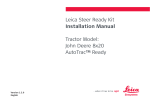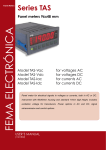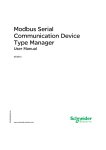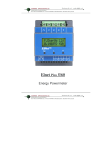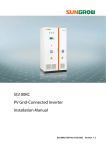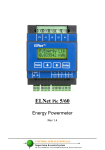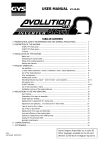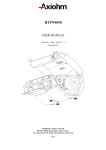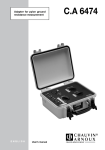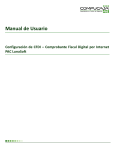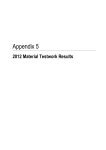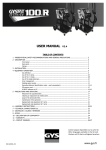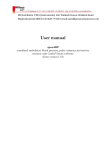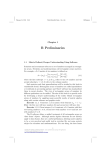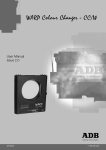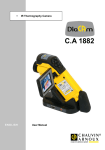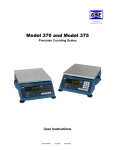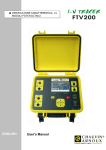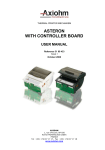Download Programmable digital panel meters
Transcript
CA 2100/2200ang - 08/99 1/03/00 11:11 Page 2 Programmable digital panel meters s ear ty y 3 ran war Thought C.A 2100 C.A 2200 out to the smallest of details... for easy set up and operation ■ ■ ■ ■ ■ ■ ■ ■ ■ ■ Very simple programming Holds minimum and maximum values in memory Linearisation of the input signal on 11 segments (C.A 2200) Serial link for remote processing of measurements Instant installation, without tools Screwless connectors easily plugged in Accessories for wall mounting and on DIN rail Supplied with 100 labels for different measurement units Styled front panel with shaped touch keys Front panel IP 65 CA 2100/2200ang - 08/99 1/03/00 11:12 Page 3 C.A 2100 6 DPM’s -999...9999 counts: process signals, load cell, temperature, voltage/current, tachometer-frequencymeter or meter-timer. Reduced depth for easier installation in enclosures and on equipment. THE RANGE C.A 2100 : 6 models C.A 2100-P C.A 2100-C C.A 2100-T C.A 2100-E U/l DC Process Signals Load Cells Temperatures AC / DC Electrical Quantities • voltage: 0...±10 V • 0...±30 mVDC • tc J: -50...800°C / • voltage (5 calibres): on 1 MΩ on 100 MΩ -58...1472°F 600 VAC or VDC maxi • current: 0...±20 mA • 0...±300 mVDC • tc K: -50...1250°C / • current (3 calibres): Front panel 48 x 96 mm watertight IP 65 Depth from under flange 60 mm under flange Display 4 digits, red LED 14 mm Input ADC Resolution on < 9 Ω on 1 MΩ -58...2282°F 5 AAC or ADC maxi (selection by programmation (selection by wiring • tc T: -200...400°C / • shunt (3 calibres): and wiring of the transducer) of the transducer) -328...752°F 100 mV max • Pt 100: -100...800°C / (selection by programmation -148...1472°F 2 000 counts and wiring input) 2 000 counts 2 000 counts Display rate 3 times/second 4 times/second 3 times/second 3 times/second Display range -999...9999 ct -999...9999 ct depending on sensor • DC: 0...9999 ct • AC: -999...9999 ct 0.1% reading ±2 ct 0.1% reading ±3 ct 100 ppm/K 100 ppm/K 100 ppm/K 100 ppm/K 400 ms 400 ms 400 ms 5s Accuracy Temperature coefficient Response time MIN and MAX functions OFFSET function Probe excitation 2 000 counts • tc: 0.2% reading ±0.5° • DC: 0.1% reading ±2 ct • Pt 100: 0.1% reading ±0.2° • AC: 0.3% reading ±2 ct yes yes yes yes yes, by keyboard yes, by keyboard yes, by program no 30 mA at 10 or 24 VDC 30 mA at 5 or 10 VDC no no Supply voltage (specify when ordering) dual voltage 115/230 V ±15% 50/60 Hz or dual voltage 24/48 V ±15% 50/60 Hz or 10.5...16 VDC or 21...32 VDC Consumption 3 W without options Weight (with connectors) 250 g without options; 320 g with options Environmental conditions use: 0...+50°C / RH < 95% Material of the case polycarbonate V0 in accordance with UL storage : -25...+80°C 2 CA 2100/2200ang - 08/99 1/03/00 11:12 Page 10 The C.A 2100-P is particularly designed for the measurement of process signals output by “high level” sensors, with direct readout in engineering units. Equipped as standard with a supply for sensors, it accepts the most widely used signals, in the range ±10 V or ±20 mA. The display rule is programmable directly from the keyboard, without any calculation having to be made. Very useful in certain applications such as weighing, the C.A 2100-P can acquire an OFFSET from the keyboard, by simple acquisition of the measured value (tare). The C.A 2100-C is specially designed for measuring loads (weights, forces, couples, pressures, etc.) by means of low-level sensors such as strain gauge bridges. Here again, the display rule can be programmed directly on the keyboard. To facilitate calibration for weighing applications, the C.A 2100 can acquire an OFFSET from the keyboard by simply capturing the measurement. The C.A 2100-T is designed for temperature measurement, from J, K, T, couples or Pt 100 Ω resistances. The measurements can be displayed in degrees Celsius or Fahrenheit, with a resolution of a degree or a tenth of a degree. By programming, an offset can be introduced to correct the possible shift of the temperature sensor. And the C.A 2100-E is specially designed for the measurement of AC or DC electric signals: voltages up to 600 V and C.A 2100-F C.A 2100-I Frequencymeter Tachometer Meter Timer • magnetic sensor: Vin > 120 mVeff • NAMUR sensor: Ion < 1 mADC / Ioff > 3 mADC / Rc = 1 kΩ • TTL/24 V encoder or NPN/PNP sensor: “1” > 1.6 VDC / “0” < 1.5 VDC • dry contact: Vc = 5 V / Rc = 3.9 kΩ / Fc =100 Hz (Fmin 0.1 Hz / Fmax 2 kHz) • voltage: 10...650 VAC - 10 000 counts 10 000 counts < 1 times/second < 1 times/second • frequencymeter: 0...999.9 ct • tachometer: 0...9999 ct • meter: ±9999 ct • timer: 99.99s to 9999h 0.01% reading ±1 ct 0.01% reading ±1 ct 50 ppm/°C 50 ppm/°C 0.1 to 9.9 s - yes yes yes, by keyboard no 30 mA at 8 or 24 VDC 30 mA at 8 or 24 VDC electric currents up to 5 A on direct input. Currents greater than 5 A will be measured by connection to a current transformer or a shunt. Connected to a tachometric dynamo or to an alternator, the C.A 2100-E allows the display of speeds directly in the desired unit. For voltage measurements, the instrument has four set ranges and an automatic range, which selects the most suitable range depending on the amplitude of the input voltage. The C.A 2100-F is intended essentially for measuring a rotation speed on the basis of the number of pulses per revolution, a tangential or linear speed on the basis of a frequency and the corresponding actual speed, a time of passage on the basis of a frequency value and the actual time, a rate or a frequency on the basis of an AC voltage or equivalent (passage to 0). The C.A 2100-I is dedicated to metering of external electrical pulses and can be used to set up a meter, a countdown meter or a time-unit meter, such as a timer or time meter. ■ In addition to the display of the input variable, the panel meters permanently record its minimum and maximum values. ■ Programming of the instrument is done by means of the three keys on the front panel. ■ Measurements can be acquired by a PC via a serial link, then processed by means of the DPMPROG software. THE OPTIONS OFFERED: • 2 alarms on SPDT relays • RS232 or RS485 serial link • 4...20 mA analogue output for P, C, T and E models; available at the end of 1999 for model F; not available for model I. 3 CA 2100/2200ang - 08/99 1/03/00 11:12 Page 5 C.A 2200 4 DPM’s "5-digits": process signals, load cell, temperature, tachometerfrequencymeter-counter-timer. Remote control functions. Perfectly suited to installations with centralised operation. THE RANGE C.A 2200 : 4 models C.A 2200-P C.A 2200-C C.A 2200-T U/lDC Process Signals Load Cells Temperatures Front panel 48 x 96 mm watertight IP 65 Depth from under flange 120 mm under flange Display 5 digits, red LED 14 mm + 1 digit, green LED, 8 mm Input • voltage: 0...±10 V • 0...±15 mVDC on 100 MΩ • tc J: -50...850°C / -58...1562°F on 1 MΩ • 0...±30 mVDC on 100 MΩ • tc K: -50...1200°C / -58...2192°F • current: 0...±20 mA • 0...±60 mVDC on 100 MΩ • tc T: -200...400°C / -328...752°F on 15 Ω • 0...±300 mVDC on 100 MΩ • tc R: 0...1700°C / -32...3092°F • potentiometer: (selection by programmation) • tc S: 0...1700°C / -32...3092°F 100 Ω min, 0...100% • tc E: -50...1000°C / -58...1832°F (selection by programmation • Pt 100: -100...800°C / ADC Resolution ±65 000 counts ±65 000 counts -148...1472°F ±20 000 counts Display rate 16 times/second 16 times/second 8 times/second Display range ±32 000 counts ±32 000 counts ±9 999 counts 0.15 µV or 0.3 µA 0.01% reading ±2 ct 0.1°C or 1°C 50 ppm/°C 100 ppm/°C 50 ppm/°C and wiring of the transducer) Accuracy Temperature coefficient Response time Linearisation MIN and MAX functions 250, 425 or 775 ms depending on filtrage programmed yes, on 11 segments yes, on 11 segments no yes yes yes OFFSET function yes, by keyboard yes, by keyboard yes, by program Remote control (4 logical inputs) 26 preprogrammed functions (see on page 6) 26 preprogrammed functions (see on page 6) Probe excitation 120 mA at 5 or 10 VDC or 30 mA at 10 or 24 VDC 120 mA at 5 or 10 VDC • hold display • display MIN and MAX • clear MIN and MAX Pt 100 < 1 mADC Supply voltage dual voltage 115/230 V ±15% 50/60 Hz or dual voltage 24/48 V ±15% 50/60 Hz or 10...30 VDC (specify when ordering) Consumption 5 W without options, 10 W max Weight (with connectors) 475 g without options; 850 g with options Environmental conditions use: 0...+50°C / RH < 95% Material of the case polycarbonate V0 in accordance with UL storage : -25...+80°C 4 CA 2100/2200ang - 08/99 1/03/00 11:12 Page 6 The C.A 2200-P is particularly designed for the measurement, over 32,000 counts, of process signals issued by “high level” sensors, with direct readout in engineering units. Equipped as standard with a supply for sensors (3 values), it accepts the most widely used signals, in the range ±10 V or ±20 mA, and can also be connected to a potentiometric type transducer, for the measurement of displacement, of length, etc. The display rule is directly programmable on the keyboard and can be linearised on 11 segments for sensors with non-linear output. Very useful in certain applications such as weighing, the C.A 2200-P can take an OFFSET from the keyboard, by simple acquisition of the measured value (tare). Lastly, four logical inputs allow four remote controls, chosen among 26 preprogrammed functions. The C.A 2200-C is specially designed for measuring loads (weights, forces, couples, pressures, etc.) over a range of 32,000 counts by means of low-level sensors such as strain gauge bridges. It can also be connected to the terminals of a DC intensity shunt. The display rule is directly programmable on the keyboard and can be linearised on 11 segments. To facilitate calibration for weighing applications, the C.A 2200-C can acquire an OFFSET from the keyboard by simply capturing the measurement. Lastly, four logical inputs allow four remote controls, chosen among 26 preprogrammed functions. C.A 2200-D Frequencymeter - Tachometer Meter - Timer • magnetic sensor: Vin > 120 mVeff • NAMUR sensor: Ion < 1 mADC / Ioff > 3 mADC / Rc = 1 kΩ The C.A 2200-T is designed for temperatures measurements, from J, K, T, R, S, E couples or Pt 100 Ω resistances. The measurements can be displayed in degrees Celsius or Fahrenheit, with a resolution of a degree or a tenth of degree. By programming, an offset can be introduced to correct the possible shift of the temperature sensor. The display of the MIN and MAX values and their resetting to zero can be controlled remotely by means of logical inputs. The C.A 2200-D is mainly intended for exploitation of pulsed logical signals for the following functions: meter with memory (batch counter, metering, countdown or two-way metering), timer with memory, frequencymeter and tachometer (frequency, rotation speed, linear speed, rate, time, etc.). The display of the MIN and MAX values and their resetting to zero can be controlled remotely by means of logical inputs. • TTL/24 V encoder or NPN/PNP sensor: “1” > 1.6 VDC / “0” < 1.5 VDC • dry contact: Vc = 5 V / Rc = 3,9 kΩ • voltage: 10...650VAC (Fmin 0.05 Hz / Fmax 20 kHz) 4 times/second • metter: ±99999 counts • timer: 0.00 s to 9999.9 h • frequencymeter: 0...25 000 counts • tachometer: 0...99999 counts 0.01% reading ±1 ct 50 ppm/°C ■ On both instruments, two digital filters can be used to stabilise the display of measurements as a function of the process conditions. ■ In addition to the display of the input variable, the DPM permanently record the minimum and maximum values. ■ Display of the measurement can be inhibited remotely by closing a contact and the MIN and MAX values can be displayed and cleared remotely. ■ On the C.A 2200-P and C.A 2200-C, the OFFSET can also be entered and cleared remotely. And the remote control functions can be modified as the user requires, with a total of 26 preprogrammed functions available in these instruments. ■ Again on the C.A 2200-P and C.A 2200-C, the display can be set to flash when an alarm threshold is exceeded. no ■ Programming of the instruments is done by means of the five keys on the front yes panel, or remotely, on a PC, by means of the DPMPROG software and a serial link. yes, by keyboard • hold display • display MIN, MAX and RESET • clear MIN, MAX and RESET 30 mA at 8 or 24 VDC THE • • • • OPTIONS OFFERED: 2 or 4 alarms on relays or opto-couplers analogue output BCD output RS232 or RS485 serial link 5 CA 2100/2200ang - 08/99 1/03/00 11:12 Page 7 Control functions These logical inputs allow the HOLD display function as well as display and resetting of the MIN and MAX memories to be controlled remotely by closing a contact. The C.A 2200 panel meters have four logical inputs located on an removable connector on the back of the instrument. RESET (function 7) HOLD (function 9) Common OFFSET (function 1) MAX / MIN (function 6) On the C.A 2200-P and C.A 2200-C, 22 other functions can be assigned to the four logical inputs by programming. Each of them is then used to control a separate function chosen among those listed below. POSSIBLE FUNCTIONS WITH THE C.A 2200-P & C.A 2200-C LOGICAL INPUTS Control None Pulse Pulse Pulse Pulse Pulse Pulse Maintained plus (1) or (6) Maintained Maintained Maintained Maintained Maintained Maintained Maintained Maintained Maintained Pulse Pulse Pulse Pulse Pulse Pulse Pulse Maintained Pulse Maintained Maintained Small details that make all the difference. These functions provide extra performance to meet the current industrial requirements. With DPM’s, it is now possible to: • Generate new functions with or without interfacing with other systems to limit the complexity of the production and quality testing equipment • Place these functions under the control of operations managed by systems which are not part of the measurement chain • Recover the data for testing in a simple way. For example: Function 10. This command, which displays the actual value of the input signal, can be used to check that the sensor is operating correctly. Functions 13 to 16. These commands index the analogue output to derived values instead of to the measurement value. Functions 17 to 23. These commands send a memorised value via the serial output to a printer or other peripheral device. Function 24. When the panel meter is not equipped with an "alarms" board, this command can be used to simulate activation of the alarm thresholds. The frontal LEDs will then indicate the fictitious status of the alarms. Function 25. When an alarm threshold declared with the latch function is active, it must be possible to acknowledge the alarm once the fault has been corrected. This command cancels the latch on latched alarms. Function 26. This command can be used to record or print the measurement signal directly after its analogue-digital conversion, i.e. without any filtering or scale factor. This means that you can check all the dynamic faults on the system. 6 * Factory configuration Nº Function Description display and memory functions 0 None When assigned to an input, it deactivates it. When assigned to all the inputs, it resets them to the factory configuration (functions 1, 6, 7 and 9). 1 OFFSET* Records the displayed value as the OFFSET and resets the display to zero. 2 RESET OFFSET Adds the OFFSET to the displayed value and deletes the value in the memory. 3 MAX Displays the MAX value. Or other pulse, return to reading. 4 MIN Displays the MIN value. Or other pulse, return to reading. 5 RESET MAX/MIN Reinitialises the MAX or MIN (depending on which one is displayed on the main display). 6 MAX/MIN* 1st pulse: MAX display, 2nd pulse: MIN, 3rd pulse MEASUREMENT. 7 RESET* Combined with (1), deletes the OFFSET value. Combined with (6), resets MAX or MIN. 8 HOLD1 Blocks the display while all the outputs remain active. 9 HOLD2* Blocks the display, the BCD output and the analogue output. functions associated with the measurement variable 10 INPUT Displays the real value of the input voltage, in mV (intermittent). 11 GROSS Displays measured value + OFFSET value = gross value. 12 OFFSET Displays the OFFSET value in the memory. functions associated with the analogue output 13 GROSS ANALOGUE The analogue output is the image of the gross value (display value + OFFSET). 14 ZERO ANALOGUE Forces the analogue output to zero (i.e. 0V or 4mA). 15 MAX ANALOGUE The analogue output follows the evolution of the MAX value. 16 MIN ANALOGUE The analogue output follows the evolution of the MIN value. functions for use of a printer on the RS output 17 PRINT NET Prints the net value. 18 PRINT GROSS Prints the gross value. 19 PRINT OFFSET Prints the OFFSET value. 20 PRINT SET1 Prints the value and status of threshold 1. 21 PRINT SET2 Prints the value and status of threshold 2. 22 PRINT SET3 Prints the value and status of threshold 3. 23 PRINT SET4 Prints the value and status of threshold 4. functions associated with the alarms FICTITIOUS THRESHOLDS Used exclusively for instruments which do not have any "alarms" option installed. 24 25 ALARMS RESET Deactivates the latched relays on instruments programmed with "latch" thresholds. special functions 26 RS ROUNDED Transmission to the serial output of the display value without rounding or filtering. 27 BCD ROUNDED Transmission to the BCD output of the display value without rounding or filtering. CA 2100/2200ang - 08/99 1/03/00 11:12 Page 8 THE OPTIONS : for the most varied of applications When ordered with the panel meter, the options will be installed by our services. They are also easily installed by the user at a later date. On the C.A 2200, it is possible to simultaneously install an alarm card, an analogue output card and a communication card. On the other hand, the BCD card rules out the installation of other options. Card 2 Alarms on relays for C.A 2100 or 2200 Both channels are independently configurable and can be set as high or low alarm. With the C.A 2200, the 2nd alarm can be set as following the 1st. On C.A 2200-P and C.A 2200-C models, the alarms can be assigned to the measurement value, to the MIN or MAX values, or even to the gross value, and can be latched, thus they act when the overvalue has disappear. The reset of the latch alarms is controlled by the logical inputs. The alarm outputs are made on SPDT relays, with an adjustable delay or hysteresis. As with the C.A 2100, they simultaneously accept the cards “2 Alarms on relays” and “RS232/485 Communication” or “Analogue Output MAN” card. The installation of the option cards is very easy. Here, the C.A 2100. Outputs Max voltage Max current 2 relays “change-over contact” 250 VAC or 125 V DC 8 A at 250 VAC or 8 A at 24 VDC Card 4 Alarms on relays for C.A 2200 In the same way, allows programming of four independent alarms, or two independent alarms with two following alarms. Outputs Max voltage Max current 4 relays “make contact” 250 VAC or 50 VAC 500 mA at 125 VAC or 1 A at 30 VAC Card 4 Alarms on NPN transistors No calibration is necessary after the installation of the option cards: the programme recognises them automatically and runs the instructions necessary for setting their parameters. for C.A 2200 It is identical to the preceding one, with the exception of the outputs which are done by opto-couplers. Outputs Max voltage Max current All the outputs of the option cards are insulated from the input signal by opto-couplers. 4 opto-couplers NPN 50 VDC 50 mA at 50 VDC Programming makes the alarms completely configurable: • HI alarm or LO alarm. In HI mode, the output is on when the measurement reaches or overshoots the value of the threshold. In LO mode, the output is on when the measurement reaches or remains below the value of the threshold. • Timed alarm. All the alarm channels can be delayed by the timer, from 0.1 to 999.9 seconds. The timer acts on both sides of the threshold, i.e. in whatever direction it is crossed. • Alarm with asymmetrical hysteresis. The hysteresis is programmed directly in display units, between 0.001 and 9999. For a high alarm, the threshold value is added. It is deducted for a low alarm. In this way, the return to rest of the alarm outputs is delayed. • Alarm with symmetrical hysteresis (on C.A 2200). The programmed hysteresis is added to each side of the threshold, defining a band in which the output is on (high alarm) or off (low alarm). • Following alarm (on C.A 2200). The second and the fourth alarm (for the 4 ALARMS cards) can be defined as following alarms for the first and third alarm respectively. A following alarm will react depending on the threshold of the alarm it is slaved to, with an offset defined by programming. The gap can take any positive or negative value. • LATCH alarm. This function can be used to keep an alarm active or inactive even if the value falls below the programmed threshold. A logical input will be assigned to cancel this latch function. A small detail that makes all the difference. On the C.A 2200, the second alarm, whatever the card, can be defined as following alarm with automatic correction of the residual measurement. In numerous cases, particularly in weighing and dosing operations, the mechanical systems and the architecture of the installation result in it being impossible to immediately stop the operation as soon as the setpoint is reached. For example, the “tailing-off” effect occurs in filling systems in which, when a programmed quantity is reached, an alarm causes blocking of the conduit. The time taken to close the protective cover and the quantity flowing during this time lapse give rise to a surplus of material in relation to the exact quantity required. The result is a real measurement greater than the setpoint (measurement residual). The “auto follow” function (AUTOTRAC) is specially designed to correct this measurement residual. It determines the excess quantity in relation to the programmed threshold and subtracts from the measurement, to switch on the alarm output with a minimum gap in relation to the threshold. Thus the surplus or insufficient quantity is permanently corrected. 7 CA 2100/2200ang - 08/99 1/03/00 11:12 Card Analogue Output Page 9 for C.A 2200 Card RS232 Communication It outputs a DC linear signal, proportional to a display range defined by programming. The output then retransmits the display variations between the two programmed points, giving rise to a “zoom” effect around a given value. The analogue output can also vary inversely to the display, if you allocate to the higher value of the analogue output (OUT-HI) the low value of the display range, and to the lower value of the output (OUT-LO) the higher value of the display range. The response time of the analogue output (60 ms) can also be increased to limit the transmission of undesirable disturbance. Output signal Accuracy Temperature coeff. Max load 0…10 V 0.1% ± 1 digit 0.2 mV per K ≥ 500 Ω Card MAN Analogue Output This option allows connection of a C.A 2200 to a master instrument (PC, PLC,...) to programme the instrument and exploit the measurements, for example using the DPMPROG software supplied with the card. Type of link Protocol Rate Output connector Card BCD Output for C.A 2200 It allows connection in a network of up to 31 panel meters to a master, to programme the instruments and process their measurements. The DPMPROG software is supplied with the card. Type of link Protocol Rate Output connector for C.A 2100 RS485 ISO 1745 or C.A, half duplex 1200, 2400, 4800, 9600 or 19200 bauds RJ11-6, with double adapter (in + out) Card RS232/485 Communication 4…20 mA 0.2% ± 1 digit 2 µA per K 500 Ω for C.A 2100 This option, specific to C.A 2100 panel meters, allows establishment of an RS232 or RS485 digital link with a master instrument. Selection is done by programming. The RS 232 link is used to establish a monopoint link (1 panel meter), and the RS 485 is used to create a network of instruments (up to 31). The DPMPROG software, supplied with the card, allows measurements to be stored and displayed on a PC. for C.A 2200 This option transmits the measurements in code form in binary decimal (8-4-2-1) at the display speed. The signals are compatible TTL and 24 V logic. Output transistors Logic Output connector RS232C ISO 1745 or C.A, half duplex 1200, 2400, 4800, 9600 or 19200 bauds RJ9-4 Card RS485 Communication 4…20 mA 0.1% ± 1 digit 0.5 µA per K ≤ 800 Ω (For P, C, T and E models; available at the end of 99 for model F; not available for model I). Output signal Accuracy Temperature coeff. Max load for C.A 2200 Type of link Protocol Rate Output connector NPN ; 40 V maxi, 100 mA maxi positive or negative SUD-B 37 pins RS232C RS485 ISO 1745 or C.A, half duplex 1200, 2400, 4800 or 9600 bauds RJ9-4 RJ11-6, with double adapter (in + out) PROGRAMMING : simplicity is the key Designed to make the job easier for you: only the instructions specific to your application appear. You can’t go wrong! The C.A 2200 panel meters can also be programmed remotely, on a PC equipped with the DPMPROG software supplied with digital link cards. Maximum of five stages, depending on the options installe : • input signal • display rule • alarms (if option used) • analogue output (on C.A 2200, if option used) • serial link (if option used) A small detail that makes the difference. To further simplify the display rule, rather than introducing by the keyboard the input values corresponding to the start and end of the scale, they can be acquired by taking into account the signal present at the input. The programme has been designed to make setting the parameters simpler, and as clear as possible : thus, for example, the instrument automatically recognises the option cards installed and calls up the corresponding programme stages. Similarly, the metrological shifts of each card are automatically compensated. Display On all the instruments, access to programming can be prohibited. On the C.A 2200, it can in addition be limited to certain instructions. P2 P1 Measurement 8 CA 2100/2200ang - 08/99 1/03/00 11:12 Page 4 DIGITAL LINKS : the choice With the serial communication options, the C.A 2100 and C.A 2200 are suitable for supervised operation by PC, PLC, or any other "master" instrument. Master RS RS 23 48 2 5 Port Com. 235 RS 485 link The RS232C and RS485 links allow : • reading of the measured values and memorised values in the panel meter (MAX, MIN, OFFSET*, thresholds). • the transmission of orders (requests, zero reset of the MAX, MIN, OFFSET* values, setting the OFFSET*). • modification of the alarm thresholds Cables P01.3194.04 Converter P01.3707.20 -195,2 43,23 *OFFSET: on C.A 2100-P and C.A 2200 models P and C. From 1 to 31 C.A 2100 or C.A 2200 panel meters in a network. Transmission takes place in half-duplex mode, using the ISO 1745 protocol or the simplified C.A protocol, at a speed between 1200 and 9600 bauds, or 19800 bauds for the C.A 2200 models. RS232C link Port Com. Cable P01.3194.03 227,5 Maître C.A 2100 or C.A 2200 DPMPROG software This software, which runs under MS-DOS, can be used to read the measurements made by the different panel meters and to program remotely one or more C.A 2200 connected in a network. The standard delivery includes the serial link option boards. DIMENSIONS AND INSTALLATION : simplicity once again Whether mounting or connecting the panel meters, we make your work as simple as possible. 45 mm Watertight joint Mounting Wall / in enclosure On table On ceiling Sym / asym DIN Rail 92 48 mm C.A Small details that make the difference. Two ingenious accessories are available, for surface mounting of instruments, or on DIN rail. Rear mounting yes yes Multiposition mounting yes, can be angled ±14° yes, can be angled ±14° yes, can be angled ±14° yes, can be angled ±14° Mounting clips 21 00 96 mm 60 mm 14 Instruments are mounted instantaneously, without tools, by means of two flexible straps that clip on to the case. C.A 22 00 120 mm 96 mm 14 The connection of instruments is by rapid connectors, with spring clips. And the connectors are removable, to make panel meters easier to mount or remove. Cross-section of cable: 0,08 mm2 ≤ Ø ≤ 2,5 mm2. The connectors are equipped with removable Lever supplied with the connector. reducers, to improve the reliability of the connection of wires of cross-section less than 0.5 mm2. No screws to tighten, means good grip over time, and the possibility of installing these panel meters without even a screwdriver. But, for those who prefer, screw connectors are available as accessories. 9 Each instrument is supplied with 4 sheets of labels- adhesive unit symbols. This makes a total of 97 A predefined measurement ~ units and 3 blank labels for customisation. bar Once they have been stuck on, the label blends harmoniously with the keys on the front panel. CA 2100/2200ang - 08/99 1/03/00 11:11 Page 1 TO ORDER Use the code tables below to order the panel meters with their options installed. For the accessories, sold separately, use the references given further down the page. • • • • • Process Temperature Load cell Tachometer/Timer P T C D Power supply Alarms 115/230 VAC 24/48 VAC 10...30 VDC Type 1 3 5 no AL 2 RELAYS AL 4 RELAYS AL 4 NPN Analogue output Digital communication User manual • X 1 2 3 no X ANALOG OUTPUT 1 no COM. RS232 COM. RS485 BCD OUTPUT* french (by default) english german X 2 3 4 F E D DPM C.A 2100- • • • • • Process Temperature Load cell Electrical Tachometer/Frequencymeter Meter/Timer P T C E F I Power supply 115/230 VAC 24 VDC 24/48 VAC 12 VDC Alarms no AL 2 RELAYS • 1 2 3 4 X 1 Analogue output ** no 4/20 mA X 2 Digital communication no COM. RS232/485 User manual french (by default) english german X 1 F E D ** For P, C, T and E models; available at the end of 1999 for model F; not available for model I * This choice excludes other options 01 53 42 12 30 Type DPM C.A 2200- Option cards • • • • • • • MULTIPOSITION MOUNTING with 2 DIN rail adapters REAR MOUNTING with 2 DIN rail adapters CONNECTOR + CABLE 1m RS232 CONNECTOR + CABLE 1m RS485 SET OF 4 SCREW CONNECTORS CA2100 SET OF 6 SCREW CONNECTORS CA2200 CONVERTER RS232-25F/RS485-screw ref. P01.3194.01 ref. P01.3194.02 ref. P01.3194.03 ref. P01.3194.04 ref. P01.3194.05 ref. P01.3194.06 ref. P01.3707.20 Card CA2XXX AL 2 RELAYS Card CA2200 AL 4 RELAYS Card CA2200 AL 4 NPN Card CA2200 ANALOG OUTPUT Card CA2200 BCD OUTPUT Card CA2100 COM. RS232/485 Card CA2200 COM. RS232 Card CA2200 COM. RS485 Card CA2100 ANALOG OUTPUT ref. P01.3193.01 ref. P01.3193.03 ref. P01.3193.04 ref. P01.3193.05 ref. P01.3193.08 ref. P01.3193.02 ref. P01.3193.06 ref. P01.3193.07 Mid-99 SERVICE : included As important as the technical performance of the product, the services offered must also be taken into account when the purchasing decision is taken. The C.A 2100 and C.A 2200 panel meters are guaranteed for 36 months against any manufacturing fault. Our service is based on a worldwide network, with a strength of 7 subsidiaries in Europe and U.S.A., 70 agents and more than 2000 distributors on the five continents. The options ordered with the instruments are assembled in our factories, at no extra charge. And for a modest price, we offer to do the programming of your instruments, to your specifications (ask us for the form designed for this purpose). FRANCE 1-9, rue d’Arcueil - BP 675 92542 MONTROUGE Cedex Tel.: (33) 01 47 46 78 85 Fax: (33) 01 47 35 01 33 E-mail : [email protected] Lastly, Chauvin Arnoux offers you an immense choice of products in its catalogue to build complete measurement systems around your panel meters (sensors, current transformers, shunts, recorders, measurement relays,...). A small detail that makes the difference. Each panel meter is supplied with a very detailed user manual, with numerous illustrations. UNITED KINGDOM Waldeck House - Waldeck Road Maidenhead SL6 8BR Tel.: 01628 788 888 Fax: 01628 628 099 E-mail : [email protected] h t t p : / / w w w . c h a u v i n - a r n o u x . c o m Also available in French and German. CHAUVIN ARNOUX 906.111.627 - Ed. 2 - 08/99 - Non contractual document. Confirm specifications before ordering. • • • • • • • • • Accessories Création & Réalisation Use the references below to order the additional option cards (additions or replacements)











